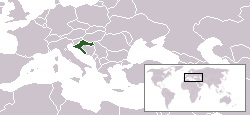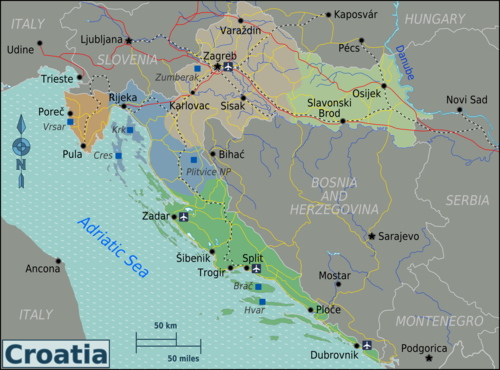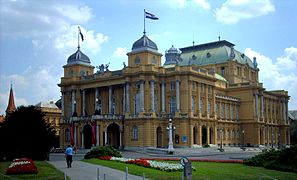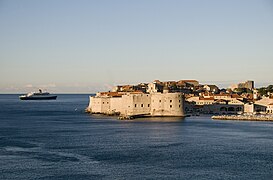![]() Click here to see the map of the area in full screen.
Click here to see the map of the area in full screen.
| Location | |
 | |
| Fast Data | |
| Capital city | Zagreb |
| State | Parliamentary democracy |
| Coin | Kuna (HRK) |
| Area | 56,542 sq km |
| Population | 4.290.612 (2011) |
| Language | Croatian 96%, Other 4% |
| Religion | Catholics 87.8%, Orthodox 4.4%, Muslims 1.3%, other Christians 0.4%, others 6.1% |
| Electricity | 230V / 50Hz (European plug) |
| Calling Code | 385 |
| Internet TLD | .hr |
| Time zone | UTC 1 |
THE Croatian is her country Of Europe and is located in the Adriatic Sea, south of Italy / Slovenia and north of Montenegro. Much of Croatia consists of the Adriatic coast, an important tourist destination with picturesque coastal towns and some green islands.
At a glance
Appropriate visit period
Languages
Croatian
Areas

There are three separate areas of Croatia, and these can be divided into 5 travel areas:
| Ίστρια (Istra) Peninsula to the northwest, borders Slovenia |
| Kvarner Coastal and mountainous area north of Dalmatia, contains the Kvarner Bay and the highlands (Lika and Gortski Kotar |
| Dalmatia (Dalmatia) A strip of land and islands between the Mediterranean and Bosnia and Herzegovina |
| Slavonia (Slavonia) It includes the regions of Slavonia and Barania (north of the river Drava), northeastern region, bordering Hungary, Serbia and Bosnia and Herzegovina |
| Central Croatia (Središnja Hrvatska) Its area Zagreb |
Important cities
- Zagreb (Croatian: Zagreb) - capital and largest city
- Dubrovnik (Croatian: Dubrovnik) - historic seaside town, UNESCO World Heritage Site
- Split (Croatian: Split) - Ancient port with ancient Roman
- Pula (Croatian: Pula) - largest city in Ίστρια with Roman amphitheater (arena)
- Osijek (Croatian: Osijek) - its capital Slavonia and important city
- Sisak (Croatian: Sisak) - largest inland port, a city built on 3 rivers, the city that stopped the expansion of the Ottomans in 1593.
- (Croatian: Slavonski Brod) - was an important fortress of the Ottoman line of defense
- Rijeka (Croatian: Rijeka) - the largest and main port in Croatia
- Varazdin (Croatian: Varaždin) - old capital with baroque architecture
- Zadar (Croatian: Zadar) - the largest city in north-central Dalmatia, with a rich history
Additional tourist destinations
- Plitvice Lakes National Park (Croatian: Plitvice Lakes National Park) - one of the oldest national parks in the Balkans and a popular destination. It receives about one million visitors a year. It has been a UNESCO World Heritage Site since 1979.
Dalmatian Islands
- Cres (Croatian: Cres is pronounced Tsres) —
- Χβαρ (Croatian: Hvar) —
- Brach (Croatian: Brač) —
- Krk (Croatian: Krk) —
- Salt (Croatian: .Olta) —

Zagreb
Χβαρ

Nrubrovnik
How to get there
By air
By train
The rail network connects all major cities except Dubrovnik (you can take the train to Split and then bus or ferry to Dubrovnik) There are direct links to Austria, Czech republic, Switzerland, Germany, Hungary, Slovenia, Italy, Bosnia and Herzegovina and Serbia.
Tourists coming from neighboring countries should consider the following EuroCity and InterCity lines:
- EC "Mimara": Berlin - Leipzig - Munich - Salzburg - Ljubljana - Zagreb
- IC "Croatia": Vienna - Maribor - Zagreb
- IC "Kvarner": Budapest - Zagreb - Rijeka
By road
To enter Croatia by road you need a driver's license and a green car insurance card. Called for roadside assistance in 1987. The speed limits are:
- 50 km / h - in residential areas
- 90 km / h - outside residential areas
- 110 km / h - on the main roads
- 130 km / h - on the highways
- 80 km / h - for vehicles with a trailer
- 80 km / h - for buses and light trailers
By boat
Ferries are cheap and have regular services between coastal destinations. Although not the fastest way to get around, it is the best way to see the Croatian islands and the Adriatic.
Jadrolinija [1] is the main Croatian ferry company, which maintains the largest number of ships and itineraries. The following international lines are served by ferry:
- Rijeka - Zadar - Split - Χβαρ - Corsoula -Dubrovnik - Bari
- Split - Ancona
- Corsoula - Χβαρ - Split - Ancona
- Zadar - Ancona
- Zadar - Dougie Otok - Ancona
- Dubrovnik - Bari
Blue Line International [2] also operates international routes:
Venezia Lines [3] has regular catamaran in between Venice and Porets, Pula, Robin and Rabak.
How to move
There are several car rental companies in like Hertz, Budget,Imperial Croatia , Europcar.
What to see
Entertainment
Transactions and purchases
Cost
Local cuisine
Local drinks
Tourist infrastructure
Studies
Job opportunities
Stay safe
Health and precautions
Respect local customs
Communications
Call codes:
Zagreb (01) Split (021) Rijeka (051) DubrovnikDubrovnik (020) Sibenik / Knin (022) Zadar (023) Osijek (031) Vukovar (032) Virovitika (033) Pozheg (040) ) Varazdin (042) Bielovar (043) Sisak (044) Karlovac (047) Koprivnika (048) Krapina (049) Istria (052) Lika / Senny (053) Mobile Phones (091) (092) (095) (097) 098) or (099)




